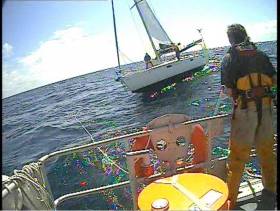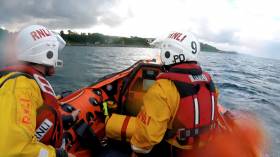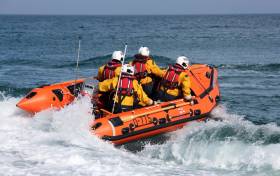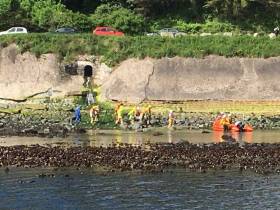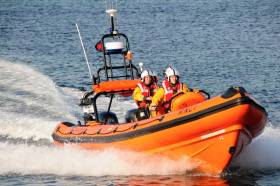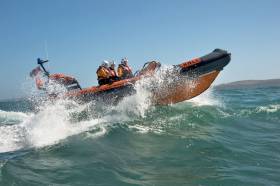Displaying items by tag: Lifeboats
#RNLI - Newcastle RNLI volunteer crews were woken by their pagers at 3.34am yesterday morning (Wednesday 26 July) after a lone yachtsman ran aground at the mouth of Ardglass Marina in Co Down.
The all-weather lifeboat Eleanor and Bryant Girling was on the way by 3.55am and arrived on scene with the casualty vessel 45 minutes later.
The lifeboat crew found the yacht hard aground and listing heavily to starboard on the breakwater protecting the marina.
Under command of coxswain William Chambers, the RNLI crew tried manoeuvring their lifeboat close to the yacht only to find the tide had fallen too much and was too far away to retrieve the lone sailor from his vessel.
With full co-ordination between the RNLI and Newcastle Coastguard on the shore, the lifeboat pulled back to deeper water and provided safety cover while members of the coastguard team carried out a rescue from the shore.
The casualty was removed from the vessel for his own safety with no injuries, and with everyone accounted for the lifeboat was stood down.
#RNLI - Clifden RNLI launched their inshore and all-weather lifeboats on Tuesday night (27 July) to reports of a pleasure boat in difficulty east of Davillaun Island.
The eight people on board had been to Inishbofin for the day and were returning home when the weather turned, becoming wet and foggy.
The volunteer lifeboat crew was requested to launch by Malin Head Coast Guard at 6.58pm to assist the broken down pleasure craft.
Once the Atlantic 85 inshore lifeboat was on scene, one of the RNLI crew boarded the pleasure boat to assist the casualties and to secure a tow line.
Four of the casualties were then transferred onto the lifeboat where they received casualty care while the remaining four people stayed on the pleasure boat as it was towed towards the pier at Aughris, over an hour away.
When the Mersey class all-weather lifeboat arrived, all eight casualties were put on board and taken inside to warm up. The RNLI crew also radioed ahead to request an ambulance to meet them at Aughris as one of the group required further medical attention.
The casualty was assessed by paramedics and transferred to hospital for further treatment. The remaining seven people disembarked the lifeboat at the pier.
“This callout shows how conditions can change quite quickly at sea,” said Clifden RNLI lifeboat helm Daniel Whelan. “Visibility became poor as the weather deteriorated. Thankfully we have a fast responding Atlantic 85 lifeboat and a well-trained crew. Having the all-weather lifeboat provide cover was invaluable, providing warmth and comfort for the casualties.
“Safety at sea is so important. Wear plenty of layers. Tell someone your plan and bring a suitable form of communication. The group in trouble did all of this which made it much easier to locate them.”
Clifden RNLI coxswain David Barry added: “This was a very successful callout with both lifeboat crew working well together to bring the casualties to safety. It was a beautiful day but the weather turned as the evening approached. We wish the patient a speedy recovery.”
#RNLI - Union Hall RNLI were alerted by Valentia Coast Guard at 3.24pm yesterday (Saturday 22) to a report of a 30ft yacht with two sailors gone aground at the middle danger in Glandore Harbour, West Cork.
The lifeboat launched and was underway to the yacht at 3.33pm in favourable weather conditions, with a slight breeze from the north.
While en route to the scene, a member of the public notified the lifeboat station that the yacht had refloated safely. The volunteer crew subsequently spoke to the sailors, who were happy to continue sailing.
Union Hall RNLI deputy launch authority Peter Deasy said: “While a lot of activity is taking place in Glandore Harbour this week with the Glandore Classic Boat Regatta, we advise people to be alert, obey navigation aids and respect the water. If you see someone in trouble dial 999/112 and ask for the coastguard.”
#RNLI - Ballycotton RNLI launched their all-weather lifeboat yesterday morning (Saturday 22 July) following a request from Falmouth coastguard, who reported the activation of an emergency beacon some 60 miles off the Cork coast.
The three-person crew of a 40ft yacht had activated their EPIRB as the vessel was taking on water and needed immediate assistance.
Ballycotton’s lifeboat crew launched at at 9.28am — and resulting tow saw the lifeboat crew on service for 14 hours, eventually bringing the vessel and its crew into Crosshaven last night.
Sennen Cove lifeboat and the coastguard helicopter from Newquay were also dispatched to the scene, but were stood down with the arrival of Ballycotton RNLI and the Irish Coast Guard helicopter Rescue 117.
Once it was confirmed that the water was receding, Rescue 117 was stood down and Ballycotton RNLI established a tow with the vessel to bring it safely to Cork Harbour.
With the lifeboat being such a long distance off shore, radio coverage was challenging. The vessel Ocean Spey, which was on standby at the gas fields halfway between the Cork coast and the yacht, helped by relaying comms between the lifeboat and the coastguard.
“This was one of the longest callouts for our lifeboat crew as they spent nearly a day at sea,” said Ballycotton RNLI coxswain Eolan Walsh.
“Many agencies and vessels played a part in the successful resolution of this and thankfully nobody was injured with both crew and yacht been brought safely to shore.
“I want to thank my volunteer lifeboat crew who despite the challenging conditions were focused on bringing everyone home safely.”
See Trouble At Sea? Always Call For Help, Says Larne RNLI
#RNLI - Larne RNLI encourages the public to always call for help if they believe someone is in trouble on the coast, following a callout this week that turned out to be a false alarm.
The Larne volunteer crew launched their inshore lifeboat Terry on Thursday afternoon (20 July) following reports from a member of the public of an 8ft punt with two on board having engine difficulties in Drains Bay, Co Antrim.
Terry and crew were quickly on scene and found the vessel making way near Larne Promenade. The crew checked that the two people on board were not in distress and had a means of calling for help if need be.
“This incident proved to be a false alarm with good intent and we would like to thank the concerned member of the public who alerted the coastguard,” said Larne RNLI deputy launching authority Philip Ford-Hutchinson.
“We would encourage anyone taking to the water to always wear a life jacket, ensure your vessel and equipment are in good working order, check the weather and tide and always carry a means of calling for help. If you see someone in trouble on the coast always dial 999 and ask for the coastguard.”
#RNLI - Newcastle RNLI was involved in a major air, sea and land search at Tyrella on the Co Down coast last night (Monday 17 July) after walkers reported seeing someone struggling in the sea.
Newcastle RNLI’s inshore lifeboat Eliza and her volunteer crew were tasked along with members of Newcastle Coastguard, local PSNI and their air support helicopter to the area shortly before 9pm last night.
It followed reports from four women who were walking on the beach that there may be a person in difficulty in the water.
A comprehensive search was carried out for almost two hours before the operation was stood down with nothing found.
Newcastle RNLI volunteer lifeboat helm Nathan Leneghan said: “Conditions were ideal for searching with very few waves and just the right amount of sunlight.
“We know Tyrella is a very popular beach and with the favourable weather at the moment we advise people to always try to swim at lifeguarded beaches and respect the water.
“We would rather be called out for a genuine false alarm than be called out too late. These women took the right action and should be commended.”
Newcastle RNLI advises the public that if they see someone in trouble on or near the water to dial 999 or 112 immediately and ask for the coastguard.
#RNLI - Lough Ree RNLI was called to assist two sailors when their 17ft Fireball dinghy was holed and began to sink on Lough Ree on Saturday evening (15 July).
The crew of Lough Ree lifeboat The Eric Rowse were alerted by the Irish Coast Guard at 7pm when the sailors called for assistance over their portable VHF radio.
The Fireball was sinking after the rudder bracket broke away from the hull, causing the buoyancy tanks to fill with water.
Weather conditions at the time was wet and windy, with a Force 4-5 breeze, frequent showers and moderate visibility.
The lifeboat crew were on scene within minutes and recovered the two sailors, who had capsized the boat in order to slow the filling of the buoyancy tanks.
After establishing that both men were uninjured, the lifeboat crew and the sailors proceeded to turn the dinghy upright and lower the sails, and then towed it to the nearest island.
On reaching Beam Island, the five baled the water out of the dinghy and examined the damage to the hull, before towing the vessel to Lough Ree Yacht Club where it was recovered from the water.
Lough Ree RNLI helm Stan Bradbury said: “We were very happy to assist these experienced sailors when they ran into difficulty on the lake.
“Equipment failure can, and does, happen at unexpected times; these two had taken the necessary precautions before leaving shore, and followed the correct procedures to achieve a good outcome if anything went wrong.
“Calling for assistance early, before you become excessively cold or tired, is the best course of action if you find yourself in difficulty on the water.”
Saturday’s callout came days after an exceptionally busy week for the Midlands lifeboat crew, in which they assisted 30 people on seven vessels over a five-day period.
#RNLI - Larne RNLI was involved in a multi-agency rescue yesterday afternoon (Sunday 16 July) after a cyclist fell between as much as 15 feet from the Coast Road north of Ballygally in Co Antrim.
The volunteer crew were requested to launch both their all-weather and inshore lifeboats at 10.15am following a report from Belfast Coastguard that the cyclist had fallen down a steep slope onto a rocky shore half a mile north of Ballygally.
Larne and Ballycastle Coastguard also responded along with personnel from both the fire and rescue service and the ambulance service.
Weather conditions were good at the time of the launch, with a north-westerly wind and a calm sea.
Once on scene, two crew members from the all-weather lifeboat went ashore with the inshore lifeboat crew to help with moving the the casualty from the beach.
The cyclist was assessed by a doctor and paramedic from the ambulance service, and a decision was made to transfer him from the beach via the inshore lifeboat to the care of ambulance personnel.
Speaking following the callout, Larne RNLI helm Pamela Leitch said: “Due to the nature of the cyclist’s fall, the position for extraction was challenging via land and the best decision was to remove him from the beach side.
“We would like to wish the cyclist a speedy recovery following what must have been a frightening experience for him. Today’s call out was a great example of different agencies working well together to bring someone to safety.”
#Rescue - Bundoran RNLI is reminding anyone planning a trip to the coast this summer to be mindful of the dangers of rip currents that can quickly sweep you out to sea.
The advice comes as Bundoran’s volunteer lifeboat crew launched yesterday morning (Saturday 15 July) following reports of several people in difficulty in the sea off Tullan Strand.
It emerged that a group of GAA footballers had been training on the beach and went swimming to cool down following their session.
The strong currents at Tullan soon began to carry a number of them out to sea and into the rocks.
Concerned onlookers immediately called the Irish Coast Guard, and within minutes both the inshore lifeboat from Bundoran and the Sligo-based Rescue 118 helicopter were at the scene.
Meanwhile, a group of quick-thinking surfers — one of whom is crew member with Bundoran RNLI — entered the water on boards and helped the footballers to safety.
On arrival, the lifeboat ensured that all casualties were out of the water, while Rescue 118 landed on Tullan Strand and also made sure that everyone was accounted for.
The lifeboat crew trained in first aid assisted eight of the players, some who were bruised and some who had swallowed sea water before ambulances arrived.
A number of the casualties were taken to Sligo University Hospital as a precaution.
Following the incident, Bundoran RNLI helm James Cassidy reminded anyone planning a trip to the area of the potential dangers.
“Thankfully everyone is safe this afternoon and we would like to wish the group well following what must have been a frightening experience,” he said.
“We would remind locals and visitors alike that Tullan Strand and particularly the area along the cliffs is notorious for rip currents and under currents and is really not suitable for swimming.
“Rips are strong currents running out to sea which can catch even the most experienced beachgoers out. They can take you from the shallows very quickly and leave you out of your depth.”
Cassidy said Bundoran’s main beach is supervised by lifeguards all summer long and provides the best option for safe, supervised swimming during the summer period.
“Should you get caught in a rip, the best advice is to stay calm and don’t panic,” he added. “If you can stand, wade. Don’t try to swim. If you have an inflatable or board, keep hold of it to help you float. Raise your hand and shout for help loudly.
“Don’t swim directly against the rip or you will get exhausted. Swim parallel to the beach until free of the rip, then make for shore.”
Further sea safety advice can be found on www.respectthewater.com.
#RNLI - Baltimore RNLI assisted two sailors yesterday afternoon (Friday 14 July) after their motorboat broke down off the coast of West Cork.
The volunteer crew was requested to launch their inshore lifeboat at 2.25pm following a report from the sailors that their vessel had got into difficulty off Toe Head.
Helmed by Youen Jacob and with crew members Pat O’Mahony and Colin Rochford on board, the lifeboat launched immediately and was on scene in 25 minutes.
The 22ft motorboat had broken down half a mile west of Toe Head and had secured an anchor. Weather conditions at the time were relatively good, with a Force 3-4 south-westerly wind and a sea swell of 2-3m.
The lifeboat crew established a tow and brought the vessel safely back to Baltimore Harbour before returning to the station at 4.35pm.
“The sailors did the right thing today requesting assistance when required,” said Baltimore RNLI lifeboat operations manager Tom Bushe. “We would remind everyone enjoying our coast this summer to always respect the water.”
Shore crew in attendance at the station were Rianne and Jerry Smith, Kate Callanan, Marty O’Driscoll and Aidan Bushe.





























